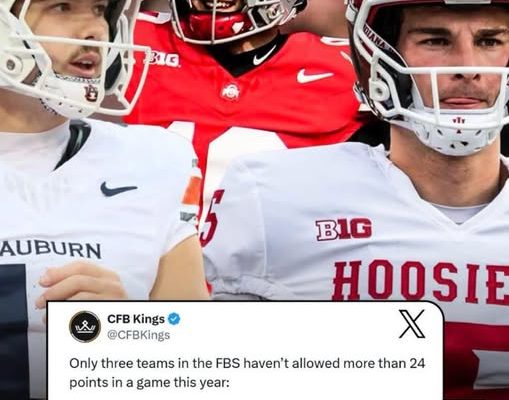The conversation around college basketball’s elite defenses this season has, for good reason, been dominated by two names: Ohio State and Indiana. The Buckeyes, with their methodical, suffocating system under Chris Holtmann, have built a fortress in the paint, while the Hoosiers, under Mike Woodson’s defensive-minded tutelage, have combined length, athleticism, and a renewed defensive fervor to stifle opponents. These two programs have rightfully earned their plaudits, their defensive metrics shining like beacons in the often-chaotic landscape of the sport. Yet, quietly, methodically, and with a ferocity that deserves a far louder national conversation, another defense has been constructed, one that not only belongs in the same sentence but demands to be recognized as a peer. The Auburn Tigers, flying under the radar of mainstream defensive acclaim, have assembled a unit that is every bit as formidable, complex, and dominant as their more celebrated counterparts.
To understand the case for Auburn, one must first move beyond the superficial and into the granular world of advanced analytics, where the true character of a defense is revealed. The common, top-line defensive efficiency metrics, which measure points allowed per 100 possessions, already place Auburn in a rarefied air, consistently nestled in the top five nationally, often trading places with Ohio State and Indiana. This is not a fluke or a product of a weak schedule; it is the result of a systemic and relentless approach. Where Auburn separates itself, and where the comparison becomes most compelling, is in the how. While Ohio State excels in forcing difficult, contested two-point shots and Indiana leverages its size to protect the rim and control the glass, Auburn has mastered the art of defensive chaos. They are the storm you cannot navigate, the pressure that never relents.
The engine of this chaos is a perimeter defense that is arguably the most disruptive in the country. Led by the tenacious K.D. Johnson and the long, agile Wendell Green Jr., Auburn’s guards apply suffocating on-ball pressure from the moment the opponent crosses half-court. This is not reckless gambling; it is calculated harassment. They funnel ball-handlers into traps, use their quick hands to dig at dribbles, and consistently disrupt the rhythm of an offense before it can even initiate its sets. The result is a turnover rate that ranks among the nation’s elite. They don’t just force mistakes; they manufacture possessions, turning defense into instant offense with a transition game that feasts on live-ball turnovers. This style presents a unique and exhausting challenge. Where playing Ohio State is like trying to solve a complex puzzle against a shot clock, and facing Indiana is like attempting to score in a thicket of redwoods, playing Auburn is a 40-minute fight for survival against a swarm of hornets. It is a different path to the same destination: utter offensive frustration.
This perimeter pressure is magnified by the presence of college basketball’s most formidable eraser, Walker Kessler. The comparison to Indiana’s Trayce Jackson-Davis is inevitable, as both are dominant interior forces. But Kessler’s impact is of a different, more statistically staggering nature. He is not just a shot-blocker; he is a shot-eliminator. His presence fundamentally alters the geometry of the court for opposing offenses. Drivers who manage to slip past Auburn’s pesky guards are met not just with a contest, but with a high probability of their shot being sent back with authority. Kessler’s block rate is historically good, putting him in a category all his own. He deters attempts at the rim altogether, forcing offenses to settle for the very mid-range and perimeter shots that Bruce Pearl’s system is designed to coax. This symbiotic relationship between the frenetic guard play and the anchored, elite rim protection is what makes Auburn’s defense so complete. The guards can afford to be aggressive on the perimeter because they have the ultimate safety net behind them. Conversely, Kessler’s job is made easier because the guards are so effective at harassing ball-handlers and disrupting passing lanes, preventing clean entry into the post.
Furthermore, Auburn’s defensive prowess extends to the glass, an area where they compete with, and often outperform, the vaunted rebounding of Indiana. Led by the relentless Jaylin Williams and, of course, Kessler, the Tigers are a top-tier defensive rebounding team. They close possessions. They understand that a defensive stop is not complete until the ball is securely in their hands. This denies opponents second-chance points, a critical component of any efficient offense, and again kickstarts their own transition game. It is the final, demoralizing step in a defensive sequence: survive the initial pressure, somehow get a shot over Kessler’s outstretched arms, and still have a big body like Williams boxing you out to secure the board. The psychological toll this takes over the course of a game is immense.
The argument for placing Auburn alongside Ohio State and Indiana is not merely a statistical one, though the numbers provide an irrefutable foundation. It is also a testament to the coaching of Bruce Pearl and his staff. They have constructed a defense with a clear, aggressive identity and have recruited and developed players who fit that mold perfectly. They have taken a transfer like Kessler and maximized his unique skillset, while developing homegrown talents like Johnson and Green into defensive nightmares. This is a coached-up unit, one that plays with a recognizable synergy and understanding of its collective purpose. They communicate, they rotate, and they trust one another implicitly, which is the only way such an aggressive system can function at an elite level.
In the world of college basketball, narratives often solidify early in the season. Ohio State and Indiana staked their claim as defensive juggernauts, and the media narrative followed. Auburn, perhaps because of its explosive offensive players or its occasionally streaky shooting, has not been afforded the same defensive reverence. But to ignore what the Tigers are doing on that end of the floor is to ignore one of the most complete and terrifying defensive units in the country. They may not achieve their dominance in the same way as the Buckeyes or Hoosiers, but their destination is identical. They grind offenses to a halt, they create offense from their defense, and they win games on the strength of their ability to get stops. The state of the year in college basketball defense has three members: the disciplined fortress of Ohio State, the long, powerful bastion of Indiana, and the unrelenting, chaotic storm of Auburn. It is time the conversation acknowledged this triumvirate, for the evidence is too overwhelming, and the performance too consistent, to suggest anything else. Auburn’s defense has earned its place at the table.



